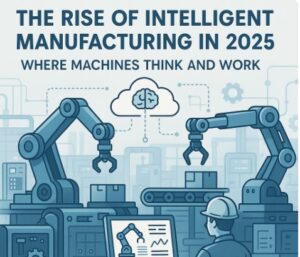The Rise of Intelligent Manufacturing in 2025, Where Machines Think and Work
 In 2025, some people will still be wasting their time and manufacturing things on their own, while on the other hand, some will be gaining knowledge on industrial front of how smart factories will start setting up in India and will be integrating AI in businesses and taking over their jobs.
In 2025, some people will still be wasting their time and manufacturing things on their own, while on the other hand, some will be gaining knowledge on industrial front of how smart factories will start setting up in India and will be integrating AI in businesses and taking over their jobs.
Yeah, it does sound like a dream, but it’s not the reality for many.
What is intelligent manufacturing?
- Intelligent Manufacturing refers to the use of advanced technologies like machine learning (ML), artificial intelligence (AI), cloud computing, and big data analytics in manufacturing systems. A system that can adapt, learn, and optimize processes without any human intervention.
How does AI helping us in 2025?
- Machines can analyze a vast amount of data to detect patterns that humans have difficulty in
- AI helps in predictive maintenance and helps in decision making
- It enables real-time monitoring and control of machinery
- Helps in remote troubleshooting
According to the sources in other words, we can say it’s a digital replica physical process or product which can be used for testing scenarios, optimizing design and create a designing pattern which reduces the time and enhances the speed.
How humans and machines work together in today’s time?
- We get machines which work by gesture and voice guidance
- Humans can focus on creative task where as machines focuses on repetition
- Sensors can predict early failure of equipment than human could
- Lower maintenance cost and reduces the risk and increases the safety
- It is customizable according to the consumer needs as they can adapt their voice, gestures, command and technology
Rising intelligence manufacturing have major impacts on economy and development such as:
- Increase the speed of production and more accuracy than before
- Lower chance of mistake and defect rate
- Low amount of waste will be produced
- It optimize raw material usage
When new innovation or technology takes place there are high chances to have drawback and challenges faced by on initial stages but to identify it and work on it can help and improve the work culture and helps to make it run smoothly and efficiently
What drawback and challenges are?
- Lack of skills
- Unable to access the machinery
- Need to upskills in AI, robotics and IT systems
- Initially there is high investment cost
- Risk of cybersecurity to access with the world
How can we solve these challenges and drawback?
- can attend events or workshop to gain knowledge
- Use of SEO to search and gain the information
- Develop themselves according to the time
- First use machinery in the presence of expert to avoid any accident on site
Future Outlooks how things will look further from 2025:
- Hyperconnected manufacturing network
- Rise of AI in businesses
- Easy to manufacture and safe plenty of time
- Greater resilience in supply chains through autonomous system
- Modernized sector
- Products will be more eco friendly and high quality
In the coming time let the development take place and start evolving according to the time stat adapting new changes and technologies to make life easier and a safer place for each and every one and Work smarter not harder!
